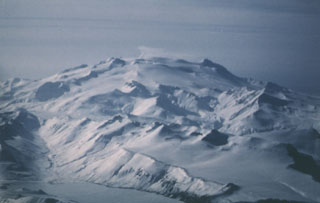Report on Makushin (United States) — February 1987
Scientific Event Alert Network Bulletin, vol. 12, no. 2 (February 1987)
Managing Editor: Lindsay McClelland.
Makushin (United States) Small ash eruption; new steam vents
Please cite this report as:
Global Volcanism Program, 1987. Report on Makushin (United States) (McClelland, L., ed.). Scientific Event Alert Network Bulletin, 12:2. Smithsonian Institution. https://doi.org/10.5479/si.GVP.SEAN198702-311310
Makushin
United States
53.891°N, 166.923°W; summit elev. 1800 m
All times are local (unless otherwise noted)
On 2 March between 1700 and 1940, a dark eruption plume rose about 900 m above the volcano and drifted SW [this was actually an eruption from Akutan; see 12:04]. After the eruption a 60-m-high steam plume remained.
An airplane pilot (T. Madsen) noted two fairly large steam vents, which he had not noticed on previous flights, on 29 February and 1 and 2 March.
Geological Summary. The ice-covered Makushin volcano on northern Unalaska Island is capped by a 2.5 km caldera. Its broad, dome-like structure contrasts with the steep-sided profiles of most other Aleutian stratovolcanoes. Much of the edifice was formed during the Pleistocene, but the caldera (which formed about 8,000 years ago), Sugarloaf cone on the ENE flank, and a cluster of about a dozen explosion pits and cinder cones at Point Kadin on the WNW flank, are of Holocene age. A broad band of NE-SW-trending vents cuts across the volcano. The composite Pakushin cone, with multiple summit craters, lies 8 km SW. Table Top (Pleistocene, 68 +/- 14 ka) and Wide Bay (Holocene) cinder cones are about 20 km ENE on the peninsula across the bay from the City of Unalaska. Frequent explosive eruptions have occurred during the past 4,000 years, sometimes accompanied by pyroclastic flows and surges. Geothermal areas are found in the summit caldera and on the SE and E flanks. Small-to-moderate explosive eruptions have been recorded since 1786.
Information Contacts: J. Reeder, ADGGS.

